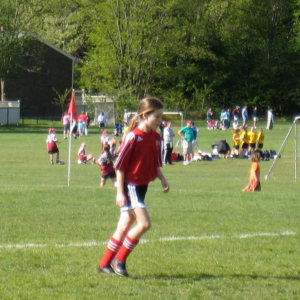Meet Katherine Paglione: Integrating Work Life and Chronic Illness
For the first time ever, Katherine Paglione reflected on her health journey and took time during the pandemic to make some serious changes in her daily life, after spending the majority of her life trying to integrate chronic health issues with school and work in a fast-paced schedule.
From An Active Lifestyle to Pain and Isolation
 Katherine was very active as a kid, with most of her focus and enjoyment coming from soccer. Unfortunately, during middle school, Katherine got a very serious concussion in a car accident on her way to soccer practice. While healing from her concussion, she was inactive and very shut down, and struggled with the feeling of isolation. She watched many things in her life change during this time, including the development of joint pain and swelling, bruising and finger nodules, which led to struggles with completing daily movements and tasks. The stress of the concussion really seemed to be a turning point for the worst for Katherine’s health.
Katherine was very active as a kid, with most of her focus and enjoyment coming from soccer. Unfortunately, during middle school, Katherine got a very serious concussion in a car accident on her way to soccer practice. While healing from her concussion, she was inactive and very shut down, and struggled with the feeling of isolation. She watched many things in her life change during this time, including the development of joint pain and swelling, bruising and finger nodules, which led to struggles with completing daily movements and tasks. The stress of the concussion really seemed to be a turning point for the worst for Katherine’s health.
After seeing a specialist at Boston Children’s Hospital due to her accelerating symptoms, she was diagnosed with Fibroblastic Juvenile Rheumatoid Arthritis (JRA). This was scary and overwhelming for her and her family because at the time, online searches only showed about a dozen other individuals with documented cases of this form of JRA, leaving them feeling alone in their search for disease management or recovery.
Katherine was first put on Methotrexate, and experienced side effects and negative reactions to the medication, including her hair falling out, drowsiness, dizziness, headaches, nausea, and stomach pain. Handling this all in middle school was extremely difficult, and she felt very divided from her peers. About a year later, Katherine switched from Methotrexate to Enbrel, an injectable biologic medication. At only 14 years old, her parents helped her with her injections – something for which she is endlessly grateful.
Two years after the car crash, Katherine was finally cleared to return to activities, but was told she’d never be able to play contact sports again. This was devastating and another emotional blow for Katherine, as the only light during the past two years was the thought of returning to soccer. For someone whose goal was to play Division 1 soccer, Katherine was devastated, but determined to pivot.
Finding New, Joint-Safe Ways to Stay Active
But Katherine refused to be held back. As she transitioned from middle school to high school, she threw herself into dance, yoga, acting, acapella, chamber singers, visual arts, ceramics, and student government. As her physical strength returned, she joined cross country running, squash, and crew – all non-contact sports that were permitted by her doctors. Katherine found a deep passion for crew, and as a coxswain, she felt like she finally found a way to channel her athletic drive and competitiveness while still protecting her head and her joints.
Katherine kept herself as busy as possible, even to the point of feeling like her schedule was completely unsustainable. She never wanted to feel the pain of being sidelined like she had before.
During her senior year of high school, she was recruited to be a coxswain for Harvard’s Varsity Women’s Heavyweight Crew team, and she was elated. She felt like all her pain had led her to this moment.
 But that journey didn’t come without struggles. Katherine remembers trying to not only juggle her rigorous crew schedule with classes and extracurricular activities, but also her arthritis. There were nights she’d come off the water and shake for hours because of how cold she was. The sport was demanding – no days off, including during inclement weather, which was very difficult on Katherine’s joints. As someone who never wanted to be viewed as less able or competent than her peers, Katherine struggled to express her needs or ask for help. This caused her to feel very fractured at times: sick Katherine vs. the well-masked Katherine.
But that journey didn’t come without struggles. Katherine remembers trying to not only juggle her rigorous crew schedule with classes and extracurricular activities, but also her arthritis. There were nights she’d come off the water and shake for hours because of how cold she was. The sport was demanding – no days off, including during inclement weather, which was very difficult on Katherine’s joints. As someone who never wanted to be viewed as less able or competent than her peers, Katherine struggled to express her needs or ask for help. This caused her to feel very fractured at times: sick Katherine vs. the well-masked Katherine.
Facing A New Chapter and Learning New Coping Techniques
She ignored the signals from her body telling her she needed to slow down. After months of ignoring crippling stomach pain, Katherine relented and went to the ER. They told her that her gall bladder needed to be removed, sooner rather than later. But because her team was determined to make it to the NCAA championship in the spring and she had a summer internship lined up, Katherine postponed the surgery. She was still prioritizing performance and achievement over health and wellness.
When the pandemic began in the spring of 2020, Katherine went home without having a graduation ceremony or leading the rowing team for her last season. The devastation and distress elevated her JRA symptoms. Her doctor switched her back to Humira, which pleased Katherine as the Humira injections were less painful and less frequent than Enbrel.
At home, without the distractions of school or sports, Katherine had no place to divert her energy. She had to be present in her body for the first time in her life. She became aware of her nervous system’s needs and how to regulate them using a combination of Eastern and Western medicine.
Katherine found that stress affected her most, followed by diet, exercise, and the weather. She began focusing on lifestyle changes and alternative ways to release stress, including massage and Ayurvedic healing. Today, she finds herself combining a lot of Eastern medicine techniques with Western treatments, with a focus on diet, exercise, and listening to her body.
Today, Katherine is living in New York City and has begun her career at Bank of America, where she is encouraged to bring her whole self to work. This means she’s less afraid and more open about communicating what her disease looks like to her co-workers, and empowers her to integrating who she is at home and at work. She’s also had the opportunity to serve as Autoimmune Co-Chair for Bank of America’s Disability Action Network, which has not only helped her make great connections, but to be more open about her disease and to help fellow colleagues develop support groups.
Now, nothing is more important to Katherine than her health, and she spends most of her time and resources trying to ease her pain, hoping for the day she’s pain-free. She is hopeful about the progress that’s been made in research, and feels grateful for having access to medicine and other treatments.
 As a young adult living in a vibrant city, Katherine now finds herself with some time and energy to catch up on experiences she missed out on during her earlier years. She enjoys trying new restaurants; spending time with her supportive family, friends, and her boyfriend; thrifting; and exploring New York City. She’s proud of how she has navigated her shift from school and constant activities to working and managing her disease as an adult. It has led her to find new independence, confidence.
As a young adult living in a vibrant city, Katherine now finds herself with some time and energy to catch up on experiences she missed out on during her earlier years. She enjoys trying new restaurants; spending time with her supportive family, friends, and her boyfriend; thrifting; and exploring New York City. She’s proud of how she has navigated her shift from school and constant activities to working and managing her disease as an adult. It has led her to find new independence, confidence.
Join our email list
Receive the latest blog articles, news, and more right to your inbox!
Related articles you might be interested in

Meet Erika: Battling 6 Autoimmune Diseases—and Advocating for Millions

Art with a Mission: John von Bergen Gives Back to Autoimmune Community Through Sales

Meet Makenzie: A Young Adult with Autoimmune Disease Navigating Life, Uncertainty, and Hope

Raising Hope: Building a Community Around a Shared Purpose
Find more resources on autoimmunity
Learn more about autoimmunity, diagnosis tips, how to find a physician, and more.